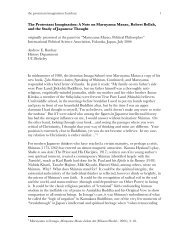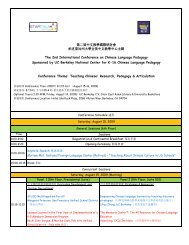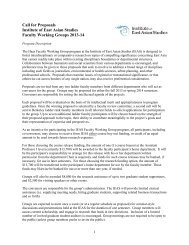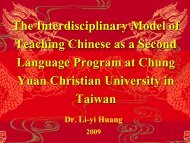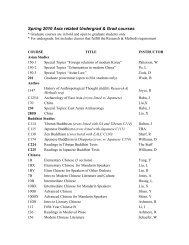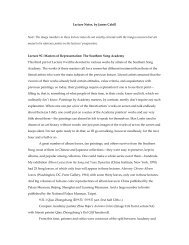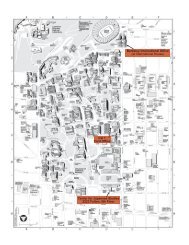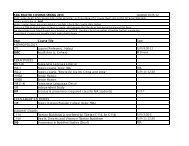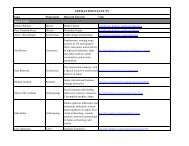Third Edition Spring 2013 - Institute of East Asian Studies, UC ...
Third Edition Spring 2013 - Institute of East Asian Studies, UC ...
Third Edition Spring 2013 - Institute of East Asian Studies, UC ...
You also want an ePaper? Increase the reach of your titles
YUMPU automatically turns print PDFs into web optimized ePapers that Google loves.
Not So Singular:Laicization in Japanese Buddhism andParallels in South AsiaRobert Bowers Curl87 Valerie BlackAbstractModern Japanese Buddhism has a unique problem: its priests get married.Compared with other <strong>East</strong> <strong>Asian</strong> Buddhist traditions, this is a source <strong>of</strong> concernas one <strong>of</strong> the major prohibitions on priestly behavior is sexual relationships.Considering that Japanese Buddhist priests not only have sex (and children)but engage in other transgressions <strong>of</strong> lay life, it is a wonder that they have notbeen cast away by their lay parishioners as poor religious figures. Yet, JapaneseBuddhism is not so unique, with its married priesthood <strong>of</strong> religiously powerfulfigures, within the context <strong>of</strong> the greater Asia region. This paper investigatesthe historical context <strong>of</strong> Japanese clerical marriage and compares relationshipmodels between the state, the Buddhist sangha, and parishioners in JapaneseBuddhism with models in the Sri Lanka Theravada tradition and the Newar Buddhisttradition <strong>of</strong> the Kathmandu Valley. The paper posits a number <strong>of</strong> similaritiesbetween the models and suggests that in the course <strong>of</strong> modernization, Japanmoved from a model resembling that <strong>of</strong> Theravada Buddhism to one resemblingNewar Buddhism.IntroductionModern Japanese Buddhism is occasionally marked as beingunique or singular in its expression, especially in the context <strong>of</strong> the“problem” <strong>of</strong> its almost completely married priesthood. While it iscertain that Japanese Buddhism is a unique tradition with its ownadaptations to its particular culture like any form <strong>of</strong> Buddhism, itis possible to find patterns within its history that appear similar tothose <strong>of</strong> other regions in Asia. This paper explores the pressuresJapanese Buddhism confronted during the Meiji period and positsthat the massive changes brought on by government programs<strong>of</strong> modernization that Japanese Buddhism experienced caused itto shift from a pattern resembling the Theravada tradition <strong>of</strong> SriLanka and Thailand to a pattern more closely resembling NewarBuddhism in the Kathmandu Valley. Specifically, the state/sangharelationship that used to be defined by state intervention in sectarianissues and attempts by government to control the Buddhistcommunity, along with deep clerical involvement in governmentaffairs, gave way to the state having a much weaker relationshipwith the sangha. Additionally, there was a marked change in parishionerexpectations <strong>of</strong> monk behavior resulting in a laity preferencefor monks that marry and engage in everyday life.In order to demonstrate these links, I will first provide backgroundon the relationship between state, society, and monks in theTheravada traditions <strong>of</strong> Sri Lanka and Thailand and in Newar Buddhism.Next, I will provide a narrative <strong>of</strong> Meiji-era Buddhist historybased heavily on the account provided by Richard Jaffe in his bookNeither Monk Nor Laymen: Clerical Marriage in Modern JapaneseBuddhism. Finally, I will compare the pre-Meiji state <strong>of</strong> JapaneseBuddhism with the Theravada tradition, and the current state <strong>of</strong>Japanese Buddhism with the Newar tradition, while suggestingthat the shift Japanese Buddhism experienced in the Meiji periodcan be construed as movement away from a Theravada model towardsa Newar model. Additionally, I will attempt to demonstratethat the claim that Buddhism is in decline in Japan must be reexaminedand understood by virtue <strong>of</strong> its altered relationship withsociety and government.Theravada in Sri Lanka and ThailandFrom the legendary conversion <strong>of</strong> the Sinhalese by Mahendra,son <strong>of</strong> Emperor Asoka, the tradition <strong>of</strong> Theravada Buddhism inSri Lanka has been linked closely with the identity <strong>of</strong> Sri Lanka asLaicization in Japanese Buddhism 88




